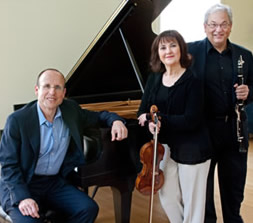The Raleigh Flute Choir, which has been advancing the causes of flutists and flute ensembles in our midst since 1986, opened the 2002-3 Friends of the Page-Walker Winter Concert Series with an attractive program October 27. The RFC’s members are all professionals, although not all work in the field; for example, former band director Thomas Mease, told us he is now an accountant at NCSU, which fact serves as yet another illustration of how tough it is to make a living in music hereabouts. The other members appear to be more heavily involved in the arts: two are managers of local orchestras, two others are managers of other local musical groups, and four of them are active as flute teachers. The program tells us that the eight flutists field fifteen flutes with “one focus.” We didn’t count the flutes to verify truth-in-advertising, but the members held up standard (C) flutes, a higher-voiced E-flat flute, a still-higher piccolo, an alto flute, a bass flute, and a rather nasty looking thing that resembled a Daliesque and slightly pregnant bassoon, made of PVC pipe, that is the newest weapon in the RFC’s arsenal. It’s a contrabass flute, no. 27 produced by its manufacturer, Jelle Hogenhuis, of Amsterdam; apparently it is the first one to arrive in North Carolina. Although it debuted here just this month, it clatters like an old car that needs a valve job (we understand that its pads will settle in over time), its notes are not terribly well defined, and it comes with a built-in microphone (not used on this occasion) to facilitate its projection in larger halls. It was played by Ann Cameron Pearce, the only member who is originally from ’round here; for the record, we should divulge that we’ve known her for a long time and that a review of one of her recitals was among the very first of our published critiques, a quarter-century ago. The other members of the ensemble are Merritt Flexman, who during the Cary concert served as the group’s leader, Debra Benson, Irene Burke, Kim Kittner, Kimberly Allemang, and Rosene Rohrer. For more information about the Flute Choir, which has twice performed, by invitation, at the National Flute Association Convention, and which has represented the Triangle at Piccolo Spoleto, the White House, and elsewhere, see http://www.RaleighFlutes.org/index.html , which site is shared by the Raleigh Area Flute Association. The two groups operate different programs with different missions. See the site for more information or refer to CVNC ‘s series tab for a list of upcoming events, which include both educational activities and performances. And for more information on the large flute family (including some pictures), see http://www.contrabass.com/pages/flutes.html [inactive 7/08].
The room at Page-Walker is small, seating only 48 people, as configured on this occasion. Not all the seats were taken. The series presents an admirable cross-section of music in our region, and tickets remain available. The next concert, on November 10, is in our current calendar, and the rest of the season is listed in our series tab. Please note that the next program is at 3:00 p.m. and the rest are at 7:00 p.m.; we mention this because at least one other paper had the wrong starting time for the October 27 program.
Residents of the capital tend to make fun of Caryites but there is culture out there, and not only Summerfest…. There’s a fine music school, a good music program at Cary Academy (where there is a tolerable auditorium, too wide for its depth but manageable), and of course a first-rate chorus (the Concert Singers of Cary, with its several choirs), and an active cultural program put on by the Town that includes the noteworthy Play with the Pros programs of the NC Symphony. In addition, there is talk of a performing arts venue for Cary, about which we will share some news at the appropriate time.
Turning (at last, some readers will surely be saying) to the RFC’s concert, we were pleased to see (and hear) that our old friend Ann Pearce continues to do arrangements for the ensemble; her transcriptions, of which she has done many, are tip-top. There are people who write original works for flute choirs of various sizes, and some of these were heard: an attractive Harlequin Suite (2000) by Ira-Paul Schwarz (from which three numbers were excerpted), two short pieces (from a larger work) composed in 1962 by Pierre Max Dubois, and lighter selections by Ricky Lombardo and Catherine McMichael, played after the intermission. Variously, these showcased the players, whose precision, sense of ensemble, balance, and enthusiasm reflected the members’ strengths.
For reasons that are not altogether clear, the arranged pieces seemed every bit as effective, and several of them were knockouts. In the second half came a version of Rachmaninoff’s Vocalise that worked surprisingly well, as did transcriptions of Elgar’s “Salut d’amour” and a dance from Smetana’s Bartered Bride . The treasures, however, were Pearce’s version of the first movement of Beethoven’s “Moonlight” Sonata and, particularly, four selections from Grieg’s Lyric Pieces that formed an outstanding little suite, the slow second movement of which (Notturno, Op. 54/4) was among the evening’s longest single selections. (Like early music programs, most of the numbers on this recital were short.)
The small crowd responded favorably to Pearce’s commentaries (in lieu of program notes) and to the music and applauded warmly, eliciting an encore: J. Harrington Young’s polka travestie “Playful Kittens” brought the evening to an altogether happy conclusion.












